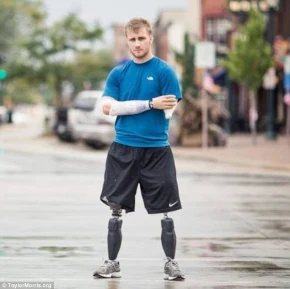Examining the Visible and Invisible Wounds of War
The public’s attention span towards wounded veterans is short-lived, despite the fact that the physical and mental effects of war can linger for a lifetime. Research has shown that the medical needs for veterans will peak thirty years after the conflict has ended. For Iraq and Afghanistan veterans, that means the greatest demand for medical care won’t peak until 2041 or later. Over the last decade, the Department of Defense and Department of Veterans Affairs have been criticized for not being prepared to handle the severely wounded coming off of the battlefield in the early 2000’s. As a nation, we haven’t begun to truly engage in a conversation about the future needs of this generation of veterans—when demand for care will reach it’s peak.
Injuries and disabilities that result from war are entangled in a web of relationships, structures, and norms that make their particular social meaning different than civilian injuries and disabilities. How we define and understand war injuries “invoke(s) culturally defined notions about what constitutes the normal experience of soldiers during and after a war” (Scott 1992:592). The presence of visible and invisible injuries from combat has not changed over the course of time, but the definitions and treatment of these injuries have taken dramatically different paths. Visible injuries, most notably limb amputations and other disfigurements, are the normative/expected injuries in combat. Invisible injuries, on the other hand, have been a contested issue in the U.S. military throughout our nation’s history.
The Visible Wounds of War
Visible wounds and disabilities that result from combat have always been an acknowledged consequence of war. Every major U.S. conflict has produced a substantial number of amputees and visibly disabled veterans. During the U.S. Civil War, amputations were not uncommon because it was often easier for overburdened doctors to remove limbs than to extract the bullets lodged in muscles and tissue (Floyd 2012). Although injuries were numerous in early American wars, the survival rate for those with injuries was low; disease killed more soldiers on and off the battlefield than the battlefield itself.

World War I Veterans at a Red Cross Event (1919)
For each generation, advances in medicine and increased efficiency in battlefield evacuations has meant that more servicemembers survive their war injuries (Gerber 2012). In the Civil War, only 44 percent of those who were wounded survived. During World War I and World War II 62 and 64 percent respectively survived their wounds. During the Korean and Vietnam conflicts, a significantly higher proportion of the wounded service members survived their injuries: 72 percent and 74 percent. The proportion of injured and disabled veterans from the Iraq and Afghanistan wars is higher than ever before, with an 88 percent survival rate for those who are wounded (Pew 2011).
With more servicemembers who survive their injuries—it necessitates a military medical system that is ready to treat these severe injuries. Each war cohort has demanded more of the military medical system than the one before it. The men and women who are the most severely wounded in combat today “need more intensive care than the most severely wounded service members from prior wars” (IOM report 2010: 97). Wounded veterans who likely would have died four decades earlier in the Vietnam War are now surviving and require the most advanced medical care. The Iraq and Afghanistan wars produced the first surviving quadruple amputee (now there are five total), some of whom are recipients of advanced procedures like full limb transplants.

Taylor Morris, Post-9/11 Veteran
The Department of Veterans Affairs even coined a new term, “polytrauma”, to pinpoint the complicated treatment required when a person has injuries to multiple body parts or systems likely due from blast-related injuries. Visibly injured veterans have always been considered as the nation’s wounded or disabled veterans—and for much of our history, they were perceived to be the only kind of disabled veteran.
The Invisible Wounds of War
While symptoms of invisible wounds have been observed for centuries, the formal definition and social acceptance of post-traumatic stress disorder and other invisible injuries is relatively new. The traumatic impact of war on war-fighters has been documented in ancient religious texts, Greek History, and in Shakespeare’s writings. What is now defined as PTSD has had many different names (some say around 80) and has been categorized in different ways—from temporary to permanent, from physical to psychological, and from an inherent predisposition to based in situational context (Anders 2012; Finley 2011; Friedman 2013). Iraq and Afghanistan veterans are the first generation of war veterans where invisible injuries like Post-Traumatic Stress Disorder (PTSD) and Traumatic Brain Injury (TBI) are considered natural and expected consequences of combat.
During the Civil War, U.S. physicians recognized those who were stricken by combat stress during war as a form of insanity or nostalgia–referring to it as “soldier’s heart” or “irritable heart” (Finley 2011: 89). In World War I, combat trauma and stress was referred to as “shell shock” and was believed to be a literal shocking of the bodily systems from artillery blasts. Those who were “shell shocked” were stigmatized by others, cited as the ones who cracked under pressure, the ones who could not handle war or who used their condition as an excuse to leave the military (Scott 1992). During this period in American history, combat stress was thought to be a temporary condition that was brought on by war but would subside shortly thereafter (Finley 2011; Scott 1992). Despite this temporary notion about combat stress, the U.S. government was spending a significant of money amount on those with psychiatric illnesses—nearly 1 billion between World War I and World War II.
In World War II, the prevailing idea was that there could be a preventative test to sort out which soldiers were likely to be mentally weakened in battle. These measures were largely unsuccessful and millions of soldiers who passed the screenings later developed psychiatric illness symptoms (Finley 2011). After the Vietnam War, veterans were characterized to be suffering from “post-Vietnam syndrome”, described as having “delayed massive trauma” by psychiatrists (Finley 2011: 95). Over time there was a recognition that symptoms of combat and trauma stress were caused by external events (such as a traumatic event) rather than something internal, such as a predisposition, as was thought during the World War II era (Friedman 2013).
The advocacy efforts of many Vietnam veteran groups ultimately led to the inclusion of PTSD in the 1980 Diagnostic and Statistical Manual of Mental Disorders (DSM), an official publication of the American Psychiatric Association (Finley 2011). This action also allowed the Department of Veterans Affairs to officially classify PTSD as a disability that veterans can receive compensation for. Vietnam Veterans fought to get the symptoms and illnesses believed to be the result of Agent Orange recognized by the VA (Scott 1992).
Today, we understand that post-traumatic stress disorder is not from a weakness of the mind or heart—that it’s a psychological and physiological response to trauma, and most importantly—that it is normal and expected. Estimates of PTSD in the post-9/11 veteran population range from 11 to 20% (National Center for PTSD).
Our awareness of Traumatic Brain Injury in the veteran population is also relatively new and has developed over the past 15 years, which parallels a greater understanding in civilian society as well. The recognition of CTE among professional football players has emphasized the cumulative impact of repeated concussive experiences. The Department of Defense has the National Intrepid Center of Excellence (NICoE) located at the Walter Reed National Military Medical Center, which specializes in treating brain injuries for today’s troops. It is estimated that over 350,000 veterans have a traumatic brain injury—ranging from mild to severe (DVBIC).

National Intrepid Center of Excellence (NICoE)
Even though there has been a greater awareness of the invisible injuries of war, there is still a stigma in the military and veteran population. Studies of current service members identify that one of the most significant barriers to getting help is the perception that their leaders and peers will stigmatize them. There is a common fear of being perceived as weak, being blamed by others for their issues, and being less trustworthy on-the-job (Finley 2011; Tanielian and Jaycox 2008). For veterans, my research on the wounded veteran community shows that invisibly injured veterans experience a constant ‘gaze’ of others who question the existence and severity of their invisible injuries, including medical professionals. While these kinds of injuries are known and acknowledged, our society still has work to do in reducing the stigma and understand the injuries that we can’t see.
Coming up in Part 2: I will discuss how the United States government has provided for wounded veterans, including what benefits are offered for wounded veterans and how our expectations the lives of wounded veterans post-recovery have changed.
Interested in learning more? Here’s some resources I recommend:
Finley, Erin P. 2011. Fields of Combat: Understanding PTSD among Veterans of Iraq and Afghanistan. Ithaca, NY: ILR Press.
Gerber, David A. (eds). 2012. Disabled Veterans in History. Ann Arbor, MI: University of Michigan Press.
Linker, Beth. 2011. War’s Waste: Rehabilitation in World War I America. Chicago, IL: University of Chicago Press.
Scott, Wilbur J. 1992. “PTSD and Agent Orange: Implications for a Sociology of Veterans’ Issues.” Armed Forces & Society 18(4): 592-612.
Tanielian, Terri, and Lisa H. Jaycox, eds. 2008. Invisible Wounds of War: Psychological and Cognitive Injuries, their Consequences, and Services to Assist Recovery. Santa Monica, CA: RAND.
Craig Walker’s Pultizer Prize Winning Photo Essay on a Marine’s Journey with PTSD: http://www.pulitzer.org/winners/craig-f-walker-0
Other Sources Cited:
Anders, Charlie Jane. 2012. “From ‘Irritable Heart’ to ‘Shellshock’: How Post-Traumatic Stress Became a Disease.” i09, April 4. Retrieved August 19, 2013. (http://io9.com/5898560/from-irritable-heart-to-shellshock-how-post+traumaticstressbecame-a-disease)
Committee on the Initial Assessment of Readjustment Needs of Military Personnel, Veterans, and Their Families; Board on the Health of Selected Populations; Institute of Medicine. 2010. Returning Home from Iraq and Afghanistan: Preliminary Assessment of Readjustment Needs of Veterans, Service Members, and Their Families. ISBN: 0-309-14764-6.
Defense and Veterans Brain Injury Center (DVBIC): DoD Worldwide Numbers for TBI: http://dvbic.dcoe.mil/dod-worldwide-numbers-tbi
Friedman, Matthew J. 2013. “PTSD History and Overview.” U.S. Department of Veterans Affairs, Created January 31, 2007. Updated August 2013. (http://www.ptsd.va.gov/professional/pages/ptsd-overview.asp)
Pew Research Center. 2011. “For Many Injured Veterans, A Lifetime of Consequences” Pew Social & Demographic Trends, November 8. Washington, D.C.
U.S. Department of Veterans Affairs, National Center for PTSD. PTSD Overview: http://www.ptsd.va.gov/public/PTSD-overview/basics/how-common-is-ptsd.asp

[…] Part 1 (read it here!) I focused on the evolution of visible and invisible injuries throughout the history of America’s […]